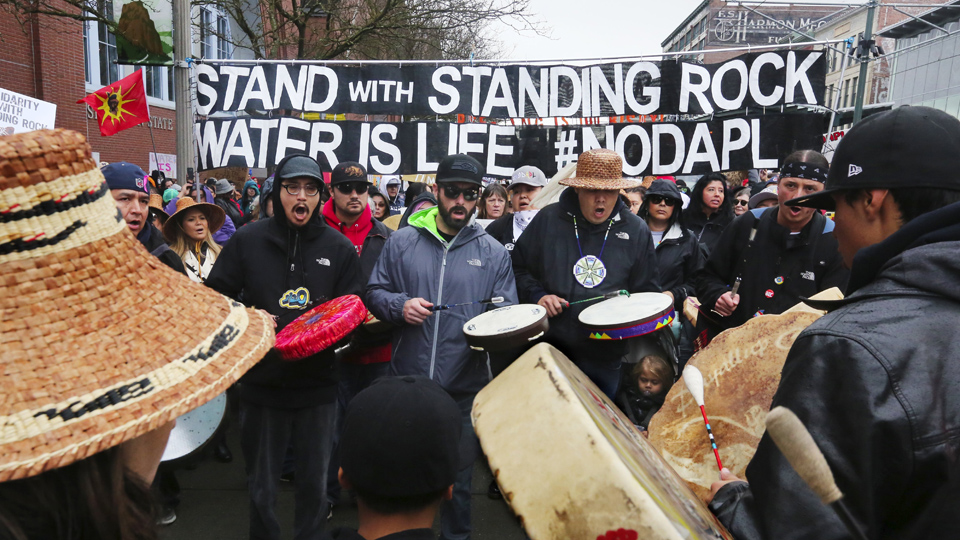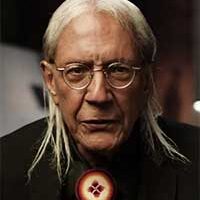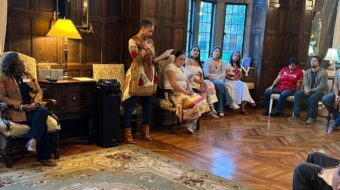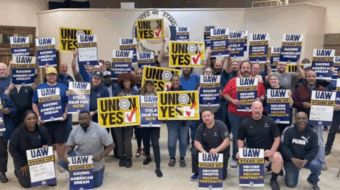
NASHVILLE, Tenn., Jan. 8 — A delegation of the Standing Rock Water Protectors spoke Jan. 8 at the Friends’ Meeting House, a Quaker facility in Nashville. Several hundred city residents attended the standing room only meeting.
The delegation was made up of two Lakota families, Frank and Rochelle Bullhead and their son-in-law Isaacs Weston and his wife Mimi, plus other relatives from Standing Rock. Weston is a graduate student at the University of South Dakota (USD)and has a degree in Lakota Studies and Mimi is a business graduate of USD. Weston was also among the heads of the Oceti Sakowin (Seven Council Fires) Camp at Standing Rock. All have been regularly on the front lines of the Dakota Access pipeline struggle, and have faced the Morton County Sheriff’s deputies, the National Guard and the oil company mercenaries.
The event was part of a speaking tour organized by Plenty International, a not-for- profit movement organization, and Frack-Free Tennessee, an anti-fracking organization. The purpose of the trip was, as Frank Bullhead said, “to get the word out.” The trip came together in the latter part of December. The tour was scheduled for January 5-15.
The Water Protectors all gave poignant and inspiring accounts of their participation in resisting the Dakota Access Pipeline (DAPL). The first good news was that it may become too cold for DAPL to drill even if they were legally allowed to proceed. The temperature when they left North Dakota was 20 degrees below zero and the machines can’t drill below 11 degrees.
In early January there were still between 500 and 600 Water Protectors at the Oceti Sakowin Camp. At one time, there were over 20,000 people in the Protector camps. Now, the longest a person can stay outside is about 20 minutes in blizzard conditions. The weather usually breaks in March or April.
Frank Bullhead recounted how he was attacked by dogs, arrested, maced, tear gassed, hit by water cannons and shot with rubber bullets and bean bags. At one time when he was arrested, the police put a number on his arm and he was held in a dog cage.
He related how DAPL had originally been routed to run north of Bismarck the state capital but the residents of that overwhelming white city put up such vehement objections that the pipeline was rerouted to run one-half mile north of the Standing Rock Sioux Reservation. They felt the pipeline would be a threat to their water supply. As Frank put it “DAPL felt Standing Rock was expendable.”
Bullhead recounted that, in the fall, 1,400 priests came from all over the nation to join Standing Rock and 16 were arrested and 8 refused to leave jail. Also, over 5,000 veterans came to join the Water protectors in December and apologized for 200 years of oppression of American Indian people.
Bullhead told of how a young non-Native activist had her arm almost blown off, and yet “they still just kept shooting us and macing us.” A young Native activist was permanently blinded in one eye when she was shot in the face with a rubber bullet.
He explained that as the weather worsened Tribal chairman David Archambault advised that women, children and the elderly should go home because of snow and temperatures dropping to 20 below.
On September 26, over 600 police officers attacked the Water Protectors; Bullhead said he responded with the message that “We are doing this for all the people.” In the midst of this epic struggle 37 policemen turned in their badges and resigned.
Bullhead said that they were fighting for 18 million people. He stated, “I am willing to die for this cause. I am doing this our children and for children to come.”
Next, Isaacs Weston spoke, the son-in-law of Frank and Rochelle. This started with the Native young people, he said, who ran from Standing Rock to Omaha, Nebraska and then to Washington, D.C. in early August. They ran 2,000 miles to present a petition bearing more than 140,000 signatures to the Army Corps of Engineers headquarters in D.C. to protest DAPL.
Weston said, “The pipeline will bring suffering, pain and illness to future generations. The pipeline is in violation of the treaty rights of the Lakota people under the Treaties of 1851 and 1868.We belong to the land and the pipelines aren’t safe.” He recalled that over the space of a few months the Water Protectors’ numbers grew from 40 to 700 to 1,000 to 10,000.
Weston recalled that the Morton County deputies “were at first OK.” But Morton County militarized itself after the federal court denied the Tribe’s request for an injunction in September.
Weston said he witnessed a young Native teenager, a young woman, being thrown down on the ground and having her arm broken. When being driven from the 1851 Treaty Camp by Morton County Sheriff’s Deputies, he said he never expected to see such police brutality. Also, one of the Water Protectors who was arrested could not be found for at least two days. He was being held in another county. He reported that he was not allowed to make any phone calls while being held, which would be a violation of his Constitutional rights.
Weston spoke of how tough it is to break through the mindset of colonization. “The Pipeline is opening our eyes to a bigger plan,” he said. He recalled that Aztecs from Mexico, Maya from Central America and Native people from Ecuador came to Standing Rock and talked of the eagle meeting the condor.
Weston said that many Native people are still healing from historical trauma. To him, the pipeline was like Columbus coming again; the second landing of Columbus. He added that is how the threat of the pipeline is seen at Standing Rock.
Two things that the Water Protectors saw as “wins” as a result of this struggle were (1) the requirement of an Environmental Impact Statement before drilling can begin and (2) now the government has to consult with Native nations when coming near or on Indian land with an infrastructure project. “It’s a good time to be alive,” exclaimed Weston. “This is a new revolution. We are not going to stop.”
Rochelle Bullhead wore a traditional “penny dress” which has great symbolism and history. The dress is bedecked with hundreds of pennies with the image of Abraham Lincoln on each one. Rochelle related that Lincoln ordered the hanging of 38 Sioux in 1862 in Minnesota for “stealing eggs.” This is a reference to the Sioux War of that year, which started because Indians were being intentionally starved by corrupt government agents. The Native Americans fought back. “They were trying to kill us then and they are still trying to kill us now.”
Frank Bullhead concluded: “We need to stop the pipeline for our children and grandchildren. I still can’t sleep and I can still smell the fire, the tear gas and feel the bullets they were shooting at us.”
“We faced the storm because we come from the buffalo nation.”










